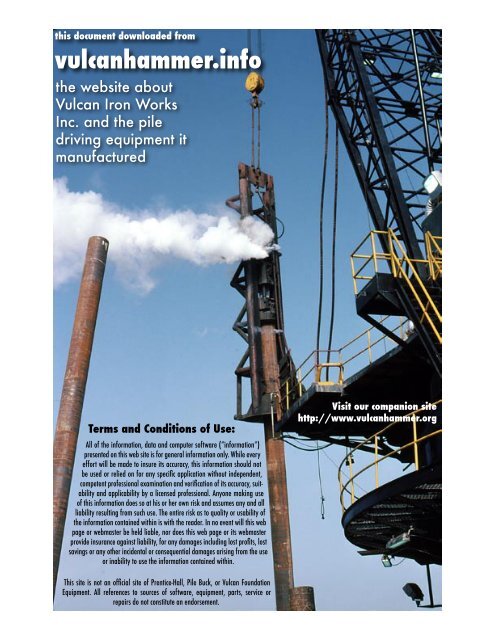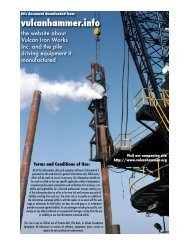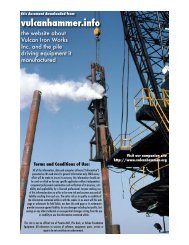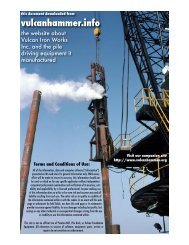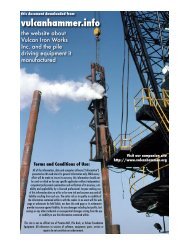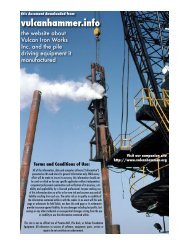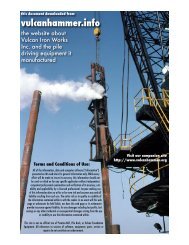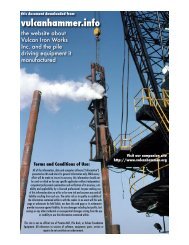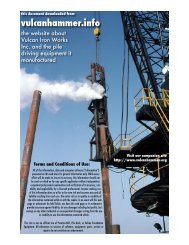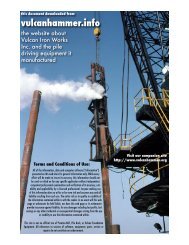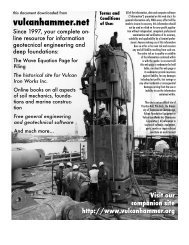Dynamic Prediction of Pile Static Bearing Capacity - vulcanhammer ...
Dynamic Prediction of Pile Static Bearing Capacity - vulcanhammer ...
Dynamic Prediction of Pile Static Bearing Capacity - vulcanhammer ...
Create successful ePaper yourself
Turn your PDF publications into a flip-book with our unique Google optimized e-Paper software.
tI5114 f b hTarch, 1969 Shl 2TITE THEORETICAL PILE MODEI,Consider the pile mode! <strong>of</strong> length L shown in Fig. 1, where .Y representsthe rigid body motion <strong>of</strong> the pile, x the distance coordinate nlong the pile <strong>of</strong> asystem <strong>of</strong> ases moving with the pile arid : the elastic deflecklon <strong>of</strong> the pint vawny from its rest position. Let concentrated forces, functions <strong>of</strong> time, FT(l)and FB (11, act upon the top and bottom respectively <strong>of</strong> the pile, and let RL(x, 1)be the distributed resistive force <strong>of</strong> the soil along the length <strong>of</strong> the pile.The top force F~(I) = the hammer force transmitted to the pile. FB (f) = aconcentrated reactive force due to the soil resistance; R=(I-, t) is a distributedfrictional force. h the model to be cons!dered here, ~ ~ ( will 1 ) be takenas the actual input force <strong>of</strong> the hnmmer as measured at the pile top for example,by a suitable force transducer. (See Rcfs. 8 and 9 and Appendix 11.)--'ainwhich E(1) is thc finite Fourier Cosine transform <strong>of</strong> the rigid body contri- (11..,--% @.- ., .,,1 !tmtion xlti the strrnnlation <strong>of</strong> [, ternls covers the transfor~ncd elastic contri- ,:;!j:.:.!I : I#,-,-,:: 'bution. When the displacement Z isohtninc4 froni Eq. 2, successfve numerical.... ;::'''.-'.;,,;!:d:.iidifferentinttons yield the theoreticnl velocity and acceleration, respectively. . . ..,411 terms <strong>of</strong> Eq. 2 arc c.qltcit]y derived in Appendix I. Itwill merely be re- ,,I-,iitcrated here that these terms are all functions <strong>of</strong> the hamnler force F~(I) ,--~ Ill:SlS rlVE FOIICI:SFB (t) will be !.?ken as zel-o in the present shldy, its cffcct (if any) bclng includedIn the dis!riht+ resistive force liL(.r,t), which will be dlscusscdsubsequently.The basic governing equation for the pile is t!~e elastic wave ec!u:ltiori. Dchils<strong>of</strong> this are considered in Appendix I. At the pile to)) (r = 0) the total dynar??icdisplacctnent under the hnnirner blow is e>:presscd by % (0, I)in which Z =A'+ 5 ................................ (1)is the sum 01 rigid body (X) and elastic (!,) con!ril~utior~s. The nct result(solution <strong>of</strong> the wave equation) may be stated in the formTIME IN MILLISECONDSConin~enls on lllc fonn nssurncd for these laws are also made in Appendix1. Esscntlally, ln lhc ex:~niples Ire:itcd in the prcscnt work, the laws are takenas (a) ;r siniplc dl~tril~l~il Coulonlb rcsistnncc nlonl: thc sicics and 01) =0, i.c. no point bc:~ring.In cnlculntion, thc Coulomb rcsistnncc was taken to be very small until thetlnle 1, , corrcslmild\n~ closely to Ihc 11c:tk bl ttlt: ~ne;tsurc.ci vc.locity responsecurve; thc fill1 reslat;lncc value W:ls cn~ployed thcr.c:tflcr. This full rcsistnnccv;\lue is callrtl C, ;~rvl Llic dctcrnlir~ition <strong>of</strong> ;i proper \.nluc for it is the prin-
P;LL NO I1SOIL CONDITXX( SILTPlLC tro ISOIL COtIOITION , SAtlD AN0 SILTTYPE. STEEL PlPETYPE I STELL PlPEDIAH ' IZ INCHESSECTION AXA , 785 ItitSfC7IDN AREA 783 IN'LENGTII I 74 f TDAM I2 INCHESULT STATIC TEST BEARINGLENGTH, 74 FEETCAPACITY 252 KIPSULT STATIC TEST BEARING CAPKITY , 214 KlPS I2.x 4d . 1 . J-6CALCULLTICH PAR.lMETERSCALCULATlON PARAMETERSCOs225 KlPSC,. 290 KlPSKO 73 KSFKO' 25 KSF./ THEO~C TICAL--- MEASUREDTIME It1 UILLISECONOSFIG. 3.-COh1P;ZIIISON OP hiEAStil!l-1) AN0 I'I?EDIC1'EI) I21(;. 4.-COhII'AItISON OF RIEASUILED ANDDYNAhIIC !1ESPOSSE OF P1I.E I l'!It:I)ICTED DYN:\hllC RESI'ONSE OF PILE I1FIG. j.-CO!.li'.\l:lS@:: OF IIE.4- FIG. G.-C05IP:?IlISOK OI.' XIE.4- FIG. 7.-VARIATIONOE' DISPLACE-SURED .4XD PIIEDICTE1) D17i:\>I- SL'IIEI) AS!) PR1:DIC'TED DY;lA:>I- hIrNT IlESPONSE FOII TIIIIEE AS-IC ItESPOSSE OF 1'E.E I11 I(: I( ES i'OSSE 01.' FU,E IIIa SUhIED DEAlLING CAPACITIES FORPILE Inn
w-cipal objcctivc <strong>of</strong> the prcsent work, since C, cnnstfti~tcs the stntic ljcnrlngcapacity <strong>of</strong> thc pile.FTELD NOilKIn the course <strong>of</strong> other portfons (see ilcf. 3) <strong>of</strong> thr project <strong>of</strong> which thepresent study was a central part, a number <strong>of</strong> steel pipe tcst piles, both fullscaleand rctlucc4-scale, were first driven and subsequently load testedstaticallv.D-dring the driving two kinds <strong>of</strong> dyn~mic irformation were measured~accelcration,and strain n e a m P <strong>of</strong> the pile. Details <strong>of</strong> the instrumentationa-vcn in Rcf. 8 and in Appendix 11. Essentinlly, a pirzoclcctric accezrom e r 2nd foil resis!ance strain gages werc r~lourited on t!ic sides <strong>of</strong> the ailenear its top. lllclr processed and rccodcd clcctrical output versus timeduring-a hnmrner blow constituic ttic main i!iput dntn <strong>of</strong> the present study.Ezan:piZToT-tfie rcsult~rz harnmr~. forcc vreti:llr curves obtnincn by Thismethod arc shown for five example pilcs ir, Fir. 2, 1;igs. 3 t!irougli 7 conhintfie corresponding measured ncccleration records. (Other tlnta are also prcsentin these fipres, as will be discusse~i :~t a 1::trr I?oi~lt.)Dah on pile static testing are detailed in Ref. 8':1nd discussed briefly inAppendix Ill. At the present point, it suffices to 11otc that stntic testing ..v:lscarried out by two different loading mctlioc!~, b~th <strong>of</strong> \ihicli gave essentiallythe same ultiinate, or failure, load <strong>of</strong> the pile. These mcti~ods ::lay be brieflyidentified by the tcrms "constant rate <strong>of</strong> penetr:itionn (CI;1)) and "mnintaineciload" (ML) test. Since it is on!y the ultirnnte load which is 1)rcscntly <strong>of</strong> intcrest,m s i s on pnr!iculxr aspects <strong>of</strong> st:\:ic load testing is omitted. Detailcd'dormation on this is reported in Refs, 8 and 9.. .1-1 tho t1111~ I ntcrvaibekeen obtnining nicnsurcd d ~ n d nt? m o! nccclcrntiori and hammer for=----.-.- end <strong>of</strong> driving and performance <strong>of</strong> x st;i!ic 1raii test iviu reduced to aminimum <strong>of</strong>s~y-._n-few hours. For cascs ufl~crc n 'sct-up* time after initial&ving has occurred, a static load test was jri-fo:-r>ic.c! f i s :\rid IV-.-I:r ~Rer ~oT.i?il~-n~-t>e :ibove stateti dviiu&-cc~I>t:iinetl.Soilconditions surroundinrrthc tesi 'lcs tliscussc~tl in :i!~s pn])cr are s -i,cificdin Appendix D!. 65~2'w~~~,--U--The aim <strong>of</strong> the study herein rcywrtcd is to 1--ctiict, tiirouyh the use <strong>of</strong> t11~analytical model prcscntcd, the static bcnriny; c:~l)azity <strong>of</strong> t!:e tcst piles fromthe d;.namic mcasurerncnts allutfcd to nbovc. Tile nlct:ioci for doing ttiis 1.viilnow be outli~ed.fiaJ.&k- -*C.*as usable. Ttrc damping ratio t; w:is takc~r as large: t, = 0.0 and was \.aricdvcrs little from this valuc in all calculations. The time I, was taken near thevalue t/c, tliough not esnctly at this valt~c, but iii the case <strong>of</strong> a full-scale pileat3 value close to [lip time <strong>of</strong> thr mnximum measured velocity response. Themcasurcd value for thr speed <strong>of</strong> sound in steel which was uscd was c = 17200fps. For better match <strong>of</strong> predicted and mcnsurcd velocity response it wasfound convenient to vary t, slightly.The computer-aidcd procedure then used was as follows: give11 the measuredforce input and the tt~cory developed in .4ppcndix 1, the best possiblcnintch between the theoretical and measured p!le displacement was soughtusing ally reasonable values for the iour pnranleters mentioned. The niensureddisplacement was obtained through double integration <strong>of</strong> the measuredaccelcr:lt~on. Oftcn an internlediatc aid in determining a good displacementmatch was to brin:: comixltcd velocity peaks !nto agreement with e.xperfmentaloncs. When 'best" matchxvas judgcd tobc obtained, the correspontling valueTYPE STEEL PIPEDlAM J INCHESSECTlOt< ASEA 170 IN'LENGTH 12 FTULT STATIC TEST DCAHitlGCAPACITY 9 5 KIPSY.I ' !-----JCALCULA7lOlJ PARLMETERSANALYSIS PROCEDUREFour parameters were chosen as \,arl3lJlC for regulating thc ;~nalytical pilemodel. Tllese are (see .4ppendlxI): Co, the cat-th rcslstnncc along the sides <strong>of</strong>:he pile; KO, a soilshenr resistance p~mmetcr; i, the damping ratio <strong>of</strong> longixdinalelastic modes in t;he pile undcr the assumtd resistance law; and I,,?ominally the time for pile-top velocity to rcach its rnz~iniu:n. Of these p-ranreters, C, proved by far the most important, lhr othcrs l~clng 'trimming"ximmetcrs only. [choosing KO = 0, t = 0.9, 1, = 1-/r (or nltrrnntely 1, = timeo rcach pcak velocitv) would effectively remove these t rininiing pnrsnletersrom further consideration.] For example, .llmost an). rr.iscp;lbIc valuc <strong>of</strong> I;,,- THEORETICAL--- MEASUREDTlhlE If.( MILLISECONDS
) ?.larch, 1963 SM 2~~~.c~nl~loycci \\,as co~;lpnrcd to the pile ultimate static bearing cxpncity.!s conlparison 1s tile 1)rlnclpal object <strong>of</strong> the paper. It is notd that theoret-? niatcliin:: <strong>of</strong> rc.';ponsr re'sults is valid only up to the point in tlmc forich velocity passcs through :I zero value.CO.MPARISON OF THEORY AND CXPERIAIENTFig. 2 ;)resents top force versus time as nleasured for all experimentales in the present study. Fig. 3 shows results for <strong>Pile</strong> 1, a full-scale steele pile 74 ft long. Theoretical and ex~erimcntal rcsults bear close resemnce,and the ;~redicted static bearing capacitv is Co = 225 kips ns opposed214 kips measured in a static load test. C, is thus Iiigh by 5%.REDUCED SCALE PILE NO. IPC, -9.9 KIPSvi;X'in this instance. This example typifies pile load capacity increase with lime.Bccat~se <strong>of</strong> thc cxcellc~~cc <strong>of</strong> thcdyn:ln;ic prediction Inthis case it also becomesa good object for test <strong>of</strong> tfjc sensitivity <strong>of</strong> thc prctltction method to thevalue <strong>of</strong> C(, chosen. Fig. 7 illrlstrntes this, where values <strong>of</strong> C, = 232, 242. and252 kips have beer1 tried, with corrcspnding theoretical dlsplaccments comparetito me;isurcd tcst results. it is clear from this that close displacementniatcliing sharply delineates the proper Co vali~e under the present method.The elastic and rigicl Body contri6utions to pile veloclty may be separatelycalculated. The elastic result contains alnlost all <strong>of</strong> the 'oscillatory" portion<strong>of</strong> the reslmnse, whereas the rigid body contribution is one <strong>of</strong> almost astraight-line decreasing velocity, suggesting the action <strong>of</strong> a rigid bmiy underconstant deceleration from constant soil resistance.Nore can be saici <strong>of</strong> the new information revealed by an:~lyses <strong>of</strong> this type.This will be reserved to n later point, alter n simplified dynamic pllc calculationhas been suggested.Fig. 8 illustrates the clyn;tnlic prediction method for a cnsc <strong>of</strong> a very shortpile (12 ft). The match acliic~ed is the worst <strong>of</strong> all cases treated as far ascurve shape is concerned, though general trends are preserved. Ifowever, theprcdictcd alti~nate stntic be:lring cnp:tcity is CC, = 9.9 kips as op;msccl to ameasured 9.5 kips, the prctlictiol~ being high by 4%.The cnlculated rigicl body nrai elastic contributio;~s for this case are presentedin Fig. 9. h'ere, in this short pilc, the c1:istic contributir-, is seen 13be reiatively much less import:int. As seen irom this figure, the mCthcwl underuse clearly delineates thc diifercnt roles <strong>of</strong> bo!h elastic nnd rigid bc~iymotions in the action <strong>of</strong> piles.In Ref. 9 ?. rigid pile m&iel u.as cmployecl. Briefly, !l!c :\nnl:;sis methodused therein was as iol:o\vs:Let .I/ bc tIlc nlass <strong>of</strong> t!le l~ile 2nd S ils :~cccl~r:ctinti; then the force b:11-\ Tlh'E IN MILLISECONDS'ig. 4 s!lows results lor pile 11, another lull-sc:ile stcel plpc pilc 74 ft:. Iiere :he n~atch <strong>of</strong> tlleoretical and expcrin~cntal curves is less satisorybut the stntic capacity prediction remains lair: C, = 290 kips asnst a measured ultinlate static value o[ 252 kips, tlic dynamic prcdictionlr here being 15%, high.'ig. 5 shows results for Pilc 111, upitti theory bcing a good match as to~e stupe in displ:~cemcnt,: velocity, and acceleration. T!le stntic caj~acity!icted is C, = 220 kips as opposed to a mensured ultimate value <strong>of</strong> 204, the dynamic result being high by 8%..'ig. 6 presents rcsults for Pilc ITIn, the snmc pilc as 111 but re-drlvcn fori:?>ic tcst .zfter a ground *set-up" period <strong>of</strong> two \vecks. Tt!c tlynnrnlc 1)l.eion<strong>of</strong> ultim;~te s!ntic cnlncity coincides with the actu:~l st:rtic tcst result
" which i;, is ti\., ::nil rcsis!nncc per unit !c:I::~I,. u:?dcr t ~ .;lssur?~l~!inn, ~thnt,oil rcsistnncc hnr the simple formRI,L = C,, + n,S + nlSa + . . ..._......_._......~ . (4)I>? \,nlue <strong>of</strong> C, mny bc.detcrn?irlcd esperirn~r.tn!!~ 11 F(,) .? nrc Lnoupn nthe instant when thc vclocit?. .I' = 0, at which insta::: LJ; ,, = C,!.Usc O! this schcnic docs In fact ylcld rcnsonablc olxfc~-~f-mn~nitu(i~ reultsfor C, xs indlcaled in Xef. 9.!!owl*er, vnrlous causes act to rcducc t]lc accur2cy <strong>of</strong> tI:is nlet:ld, thehief ones being the elastic action <strong>of</strong> the pile and the tvpicnll~ moscillntor)-"r 'hashye- appennncc <strong>of</strong> the usual scc~lcrox~:~~ record, \r)lich :nust be rend3 ol)hin :I? thc pint wllcrc its tin12 int~::~~] ,? pnssr.5 t,h:.ot!c!l zcro. Thcarticularly rapid local var-iations <strong>of</strong> s in :lie rc.c:ioil <strong>of</strong> .Y = 3 render thee.?tfin,c <strong>of</strong> X there quite uncertain <strong>of</strong> fntcri?~-c~2tinll.One very esefu! schcnic for the cor~.cctior: 0: tllc..;c! iii:~ccarncies is !o plotilr from xq. 3 for :ill timcs I <strong>of</strong> ir;tcrcst to 2 ::ivc:, )::::l;,::cr. !,leu' (i.c. scv-:![ tens <strong>of</strong> lililiiscco~is). .( typicnl rcsuit <strong>of</strong> tllis 1:iritI is s!~ou.n in >-16. 10.::?IT, l?cgirlning xpl)rosir.iatcly at ti;:lc :, .: an:! c~::!i::iz nl;~)ro?:imntcly)en S pnsscs throilgh zero, or for :i:iy c!:nsl~~l s!:ortc~ tin!(. in!crvni, tile;:c nver:lge ol I,iiL(1) is obtained. 7'liis :ivcr-:lge ]~!.ovcs'to bc r!uitv closc tothcr the nicasurccl or the dynnmic:iliy cnlc~:l::tcc! \.;lli:c <strong>of</strong> C,, csl)r?ci:tlly ifover nn intcrv:il in tllc \?ci!iitj. <strong>of</strong> I,, u.licrc ,? pnsses throt~gh zcro. 'i,ticsired tilne a\.eragc cnn <strong>of</strong>ten bc n~ndc cjuitc tccil by r:;c bj. r;iml)ly fnirii~g :Irnight line through thc plot <strong>of</strong> LnL(t).This schctnc is, ififact, littlcc!i!:crerit ill c!fcct from nncltllcr vnrlnnt whicll1;. xlso be used: a best fit straight line is inl:.cii 111:-ough tnc dcsccndingrtlo~: <strong>of</strong> t1:e velocity cilrvcs like thosc in Figs. 3 through G, anc! t!ic slope <strong>of</strong>3 Ilne is considcrcd to be the rlgicl bcxty dccclerntio~l; then uslng Eq. 3, rrirch the value <strong>of</strong> F~(!) Is, rend <strong>of</strong>f 21 thc time v.,hcrl the :.:ireti straight vc-:ity line pxsscs through zefo, yiclds 2 vnluc for LR,.--Thnt such xpproxlnnte schemes mny work qultc well is nttcstcd to by thesi11ts pr!rayed In Tnblc I. Thc flrst column Iderltiflcs the 11ilcs dfscussctlcviously under thc clynnmic nnalysis iiicthcai. Colunln 2 t:lvcs C, ns lountl 11y: ni:ltcllinp nlell,od. Column 3-~ivcs t!~c rcsisl:~ncc calcuInttxi from only t11r:Id M y portion <strong>of</strong> the prcdlctctl dyn:tlnlc rcslmtisc :it tlic pint wllcrc thevrlocft). pn!;scs t!:r.nul:h zero. Colun~n 4 s)?ni'.s rc!jlll(s <strong>of</strong> sinlplificxl nvcr:~[:ingin th" ncir;11!x~?l?ncxi <strong>of</strong> I n Irn::tyf on I;;". 3. Colilnln 5 pl-c~cilt~ nrtlrni stntfc testrcsults for oltir:i:ltc Ionti bcarlng cnpncity.I! nl;t!.. fr-nr I1rr:sr rpsrllts, ~rprrd !ha! t!:~ .:cry prncticnl fr:ll>hlc:~ln\$crnt:i~l[; mc:hfi-Is st1ggcstcd, do in f:ict, ytc!c! ~ocd rcstl:ts in thc cnscs consii!crrtiand render the nlorc elaborate computer ~r~ilysls urulcccssnry CXccl'tns n rcsc:lrch tcoi. l')lls is 3 decided ndl.nnlngc, suggestin[:!he posslbili!?.<strong>of</strong> rnpid cncincering ~ s t i ~ ~ <strong>of</strong> : pllc ~ t i static ~ ~ bra!-lng capacity In thc fieldtll:oLlgh the Use <strong>of</strong> instlumentcd dynnmic tests.V:!li!c cnrlicr ni:alyticnl 1;lcthods )lave nlrcxdy 1)ccn prcse~lted ill tlie litcrnturefor nn:llyzing pile drivirl~ "by the \i.nvc cquntion." the ~Ircscnt ni~thodc!ircctly cn~nbincs and cnl::;,nrcs tllcory \vi!i~ corrcsmndlng clynxillic t2.\:l)crimclit.'1%~ nlcthoc! <strong>of</strong>fers t!~c possibility <strong>of</strong> tl:;n:lr:lic ill p!:~cc <strong>of</strong> sL?tic londkcstir.!: for pllcs, :lt Ic?.st in ccrt:\in ty])cs <strong>of</strong> soil.In tlic prcsc11t co:!tr:., 11:~ rllc:lsul.rd }i:Lll)n~,-:. fi):.~~: is tnkc:) ns illl~~t, ':-7 -I']"ci::j n:lt[ dis*,ker-lio~ri..,- ~ ~ ~ ~ i d ns f rn c ; d ~ 'Tlrc u n;~l:,-tic;\l mc:]~ri(i :>-1s!7.l!ntrs - t!-,(. s:i:l!i. in:izt :I;;qt. Lt'licn thr-n~:itch bct\vi:e:: :~cLun! :\::il ~,rt.c!ictcd ot!!ir,~t is r:cior!, t!ie !)rciIhdb~ 0: st:iticsoil resist?.nce nlso nl~!:en:-s tobe good. l e i s \rork:t co:,tinuous pile morici-&her tnnn 2 set oj fi~c~.ctc ~~)rir.g-~ilnsscs--\i.ns LI!;CC!. \?'hi!r ~!IC con!inilOuSco;lsta:,:-sccmn r,iie :nC <strong>of</strong> ti!r \JCI!I:!:; 11: ~III. 5ttltIy is 1Il:rt this 11;:ly1 , ~ ~;os.c.ii>lc fordyn:!rnic tcsts just :IS It IS for sl:i:ic I~sstS. 'l'n u-11;lt cxtcn: :hisI>rovcs to I)e 1:uc for :kli typcs <strong>of</strong> soil is :k si~l)jcct for co~:ti::uin;; study. It mnyt.vc11 1-cquirc morc tlctnlicd rci:ntxl lo tlic clcfinitio:i <strong>of</strong> tl:~' ;lssurnrcl resis::lr:ccis :ilo~ll: tlic ]>llc. It is !101)~d that ll[:li! nl:ly l>c :;!!I:'! oj:~i:i this i~y t11e esj~cricncc<strong>of</strong> otliers nnc! tll:tt const~-\~ctivc co.rn11rcnt Illnx l)c clicltccl on this point.One <strong>of</strong> tile nddltlon:il qucstlo~~s is Ihnt <strong>of</strong> tllc pi;(: tnr ~.rsist:incr. For pointbc:lringpiles a form for lhls, FIJ(!), milst bc :~ssanirltl. Thc 1,rcscnt stuc!)' h:isslrccccdcd to ;! rcnsonnblc cxtc:1t \l:ith n \+cry si:l~l)!c o:cr-;~ll ~.c.sistnncc ln\rp.Continuin!; stutly rilny in:l)rovc [his Inuv.I'hc nttcml>l hcrc to :lc!lIcvc sim)~lc tlyr!:tniic ~:stir:i:\tc~s <strong>of</strong> bc:~riny: cnlxicltj'tl~rou::li :ilorr rn:;lIy np!,iic.cI critc~.l:~ 1~1s :\]so :,-lcldctl c.llcour;\gill!; results. Jn]);it-lfcular, the s:ltlcn: cilnr;ictcris!lcs o[ tllc 11ilc :lctlvity urltlcr tire it:tmn~cr-.. . !!~~?i:;g.. .I' ' .: i;:..?i: :. h;. , .!: , 1,:. g,:;. # 6--. v;:,:!;i-:b. ;, . 2.7:.. ,,.- 2: ;/r:?* 7, . f.:.. x:ic:.':. , f.!..E 41:. - f. 1ti:ff '
%(as cxcn~plificd, my, by the velocity rcsponsc) arc brou~ht out rnthcr clcnr:y,and tiir.cct !)tiysical intc:pretations <strong>of</strong> thc output h;~ve bccrl possible.Through studies <strong>of</strong> the type pictured in Fig. 9, the rcl;~tivc rolcs <strong>of</strong> clnsticard rigid hndy actiLrlty nre distinguish:d. For both !on7 and short piles thevelocit:, pr<strong>of</strong>ile atpile top- rf?ve2l~first a period <strong>of</strong> strong elastic compression<strong>of</strong> the entire pilc, followed by a rigid M y deceleration as the compressedpile penetrates the ground; upon this deceleration pr<strong>of</strong>ile arc superimposedelastic oscillations <strong>of</strong> a 'minor" nature probably originating in the region <strong>of</strong>cap block-linnjmer interaction. (They are not due to w:lvcs ~unning up 2nddown thc pilc). In the case <strong>of</strong> long length, the pile 'compresses up* like a longspring under steady load, up to the point <strong>of</strong> rnasinium vclocity; thcn thc comprcsscd~)iiedescends into the soil more or less lilte a rigid tmdy. In the cxse<strong>of</strong> the short pilc, the rigid body action is the pr-incipal one, \vith only a relntivelysmall clarjtic effect exhibiting oscil1atio:ls about a niexn much Iiearerto zero. i"11esc considerntions esplnin \vhy the rizid botiy model <strong>of</strong> pile activit;(9) p~-ol,c(l adccjuate for a period <strong>of</strong> time in csplainin:: short pile ztctivitybut failcti to cs1)lain long pile activity atlcquntcly. Both cases nrc reasonnbly11nrdlc4, however, by the siniplified averngirlg nlctllods outlined above.For. the autliors, tlie present study has rcsu1tc.d in fnmiliariznlion with tlier~pitlly passing response pr<strong>of</strong>iles actually occurri~l; over a few tcns <strong>of</strong> n;illisecondsafter the han~n~cr inipnct. These rapidly cvolving pr<strong>of</strong>iles are no\rVboth bclievzblc and physically c:q)l:tin;tbls.Two particular facets <strong>of</strong> pile rcsponsc thnt h;~vc proved irltercsting, andpcrhnps unc:.:pcctd, are thc following:First, the onsct<strong>of</strong> the vclocitv response is a curve resembling the form 01thc curve <strong>of</strong> FT(!). That tllis is not merely coincidcntnl arid in fnct thnt the:wo cl;rves 21-c re1ati.d by :I constznt<strong>of</strong> pr.oportion;llits C,'-!:I is czsily denionstrable(8) when the responsc to I.-?(!) <strong>of</strong> an infinitely long elastic pile withno resistance is calcuhtcd. (A convenie:lt device for this d~rnonstration isthc us:: <strong>of</strong> the Laplace transform in solving tl~c elastic w;i\.c cquntio11 <strong>of</strong> thepile.) Thus, thc c:lrly part <strong>of</strong> the velocity currvc rc)~rcsents 'rvhat is going onc.iastic:iily ljcforc the soil rcsistnncc takes tiold.' R~~.ther. tvller~ ti;? cx~ierimcl:t:~llj.mcnsurci velocity 2nd ~ ~ . ( curvcs t ) part cornl~ari:; ti;< crfect <strong>of</strong> soilresistance c;idrntly has begun to bc fclt. Th~s occurs usually :it or near tiicxnln.?imum velocitv pe.llc, at :I tinie I, = L/C.Send, the pile wave sent clown Ilv the h71n!?,er blow.ci~ss.qntr.: . in I. themost pnrt, dircctly into tl~c soil on the tiownward pnssngc, anci little reflection<strong>of</strong>%c ;varVe occurs. cs unoer ttiese constderations thnt Lhc j~i~c mny oc vtsualizcdas -cornpr.esscd clown" and to 'actas n rigid LMtiy" for a tinie tlierealter(Fig. 9).The emphasis in the ,present paper has becn on thc prtdiction <strong>of</strong> dynnmicresponse for thc purpose <strong>of</strong> predicting static bearing capacity. Driving hammeriorces, as nvallablc, 11avc becn assumed adcc!unte to the job; hence noguidelines arc est:iblished in this work for deternlinin~: tllc necdcd niagnit~~fe<strong>of</strong> available driving force or energy. Ilowcvcr, it is clcar from recoids likethose shown in Fig. 2, thlt good knowldge <strong>of</strong> developed driving forces cnn beobtained by tllc methods us& and corrclatctl with othcr pile irJormation,such as displncemcnt, to detcrrninc d rivlng cn'eriy and required hamnicrc!iaractcristics.?'he hnmnlcr forccs shown in Fig. 2 nrc tliosc for :I p;irticulnr 1i:tnirnerimpact <strong>of</strong> cnch pile consiclcrcd in this jl:Ipc?r. A rccoid~d hhmrner force was-3ialtiercic n~casurcmer~tirnrler all conceival)le clrcu~nstances.It docs, however, prcsenl more than coincidental evidence that such a problcrnmaj. bc Well-posed and that continu& cffort In th!s direction can resultin even cvccllcnt and rapid dynnnlic predictions <strong>of</strong> pile static bearing capacity.The full rangc <strong>of</strong> applicnbility <strong>of</strong> the method as well as its limitations arcobjccts oi continuing study by the \vriters.A portion <strong>of</strong> thc thcorctical work and the entire ex~~crimcntal work rel?ortedhere wns sponsored at the former Casc Institute <strong>of</strong> Tcch~ology by theOhio Highway 1)cpnrtmcnt and the U.S. Bureau <strong>of</strong> Public Roads. The opinions,find~ngs, and conclusions cvpresscd in this paper arc those <strong>of</strong> the writers andnot necessarily <strong>of</strong> the Shtc <strong>of</strong> Ohio or the i3urcnu <strong>of</strong> F'ubiic Roads.he writers arc lizrtfculnrly rndebtcd to the rocicwcrs <strong>of</strong> tlie origin31manuscript <strong>of</strong> thc pnper for thcir mxny constr,ictive sagzestions and comments.APPENDIX I.-THEORY OF THE EL.AfT1C PILE---The basic Eovernink: equ:ttioti is :he clnssic;c!, onr-dimcnsionni elnsticwnvc ecluatioii, \v~-ittrr, for t!lc pile \rith n icsist:i:~cr! tcsrn RI /(il E) includedin :r.hic!l c = :.f:r$ i.? thcs o.:ivc vclocit:; in tlli. pile. n;::lcri:ll, 1 is .the ])ilc materi:iicicnsity, I: is tlic riioduli~s <strong>of</strong> 01:lsticily <strong>of</strong> tkis 1:1;1tcri;~l, :tncl ..\ is thc pilecr-oss-scctiori:ll :Ire:t. (I'ilc tic:td wcic!~f Is ri~.!:!(.c.tc.~! In Eq. 5. It is :I ric(!ligib!cfraction <strong>of</strong> thc u1tiril:itc 11ilc st;ltic c:~]jac:ity).Tl~c bo~~ritinry contiit inns :trc,\ ,; 5 - F- (.I = 0) (! .r 0) .................. (Gn)n ,. y41)'I'!le initial co~~ditions arc quiescent.Y(O) + SLY, 0) = 0 (0 := .r 5 L) . ................. (70)
tile cove rning cquation becotnes .k- 3In particular, at x= 0, the pile topNow let the soil resist'ance take the formn,(x,O = R,(.Y,!) + D i(7,i) ........................ (10)in which D = d A E ................................. (11)for an appropriate 'damping coefficient" (I to be defined latcr.Taking the Fourier cosine trznsiorm <strong>of</strong> Eq. 9 yieldsThe folm and application <strong>of</strong> the soil resfstance force law gixrcn by Eq. 10needs further e1ucid:ltion. 111 the presctlt worlr the constant contribution %(x, 1):rill be defined and applied as an uactive" force as followsin which the barred quantities together 'vith the subscript c rcprescnt the finiteFo~lrier cosine transform- r L71- Y%, (11, I ) = J z ( s, 1) cos - A\- ...................... (13)0 LIt is retnal.ked in pnssing that t!l~ rosine transform is e~:iplo:rcci bc~nusc <strong>of</strong>its approprintcness to thc presrnt bounti:lry contiitions.Solutions <strong>of</strong> Eq. 12 is given by- - : II(,l, T) c-?'(t-+.......Z, (?I, 1) = & (91, t = I ---------- sin ;3(1 - 7) (!T (14)for )I = 1, 2, 3, ...cZ/lin which : = - 20 ,'jin which C, is constant for all ,Y 2nd I 2 1,. The tlme I, will be arbitmrilytnken as f, 2 L/C thc time for an elnstic wave to tr:lvel fro111 top to bttonl <strong>of</strong>the pile; however thc exact value c!loscn for !, cnn be considered a parameter<strong>of</strong> the solution as used here.nnc! ci is to be defined aswith [ = ratio <strong>of</strong> damping to critical, so th.it e:xc'h mode <strong>of</strong> the response h:isthe same da~nplny rat10 5:For the case ?I = 0 (Eq. 12) yields the rigid bdy contributlonfrom which Tc and yC are obtnined by successive time integrations.The net solution for Z(,Y, f), the total tl1sl)laccmcnt 01 a pint on the pile,is given by*0- -117vZ(U.I) = "'(') + 2 1 {,(11,!) cos - .................. (16)L LWtlile many definitions <strong>of</strong> i;,(y, 1 ) tll~gtit 1.1~ nl:~de, 2nd iurt!icrcs;~erin:entationin this direction is vcry wortll;vl~ilc, thr: ;il,ove definition has provenadequate in c.unmples :;tt~tlired to date. In othcr :-:ords, a tot:\l stirtic soil rcsistance<strong>of</strong> arnount C, is nssunicd tobc,!:in actink: inst:intly oncc time 1, = 1.l~hasbeen rcnchcd. We llotts that sotnr: 1:iw <strong>of</strong> resistnllcc G'!lich tlcfincs the time<strong>of</strong> coming into actiorlis necess:iry in th~..~~r~set~tcont(~xt; Tills si~i~lehas worked well in : variety <strong>of</strong> cs;lnll)lcs. Under t!lc stated :~ssurilption theresistance R,(y, :) 11;is tlic forni indic:~trd In Fig. 11.One slight n~odiiicatiotl <strong>of</strong> thc :ibovc schrnrc for rcsistance I
P;.r K(X) a cocffiricnt dc~cr:tling llpon soil shrar resistance at thr pile-sot1~terface. For sini]>licity was taken as a constant K = h', thrnu~houthe pileength. it !nay be ~~olnted out fn advance <strong>of</strong> the csa~nplcs considered that thiscsistance law, essrntinlly an "elasto-plastic" law, for timc prcccding 1, =./c, had small cffcctupon t:ic rcspmsc, wRatevcr the ,-:L!UC <strong>of</strong> K chosen, onlyausing smnll changes in the early and less signiflcnt~t jmrtion <strong>of</strong> the calcu-~ted pile displacement response. The form <strong>of</strong> t!~e correspontli.., 7-.. sot1 resislnccInw as a function <strong>of</strong> time is suggested in Fig. 12. The values <strong>of</strong> Z uscd1 the lntter modified resistance law were simply taken as those nleasured atie top <strong>of</strong> the pile.It should be remarked that certairl series convergence problen~s connected.ith the conlputer evaluation <strong>of</strong> Eq. 14 hecessitated special attention. Theseroblcrns were resoived essentially (a) by uork~ng directly with displace-.cnts in the form given hy Eq. 17 from which the velocity and acceleration.re obtained using a finite difference approsimation schcnie, and (11) by em-3 :conisratlon. At first str:lin gages wrrt molinted directly on the outside pil~picnlly, a high paper sped (60 in. per sec) was uscd when recod-I: a plle I~anirner blow.To mensure hammer force a variety <strong>of</strong> procedures was tricti, :~il crnteringround the use <strong>of</strong> foil resistsnce strain g:q:es in a bridge-c:trricr nrn:~li[ierdl.ivil>c and ulmn restriking the pile \~;rs achicvcvl by conc!itioning the str3illsignal with a carrier nn~plifier which in turn tlrovr :I gnlvnnometcr <strong>of</strong> the;~bove-mentioned recorder.~-~~-~~~-ieato-th~d in-! truck. Qccnsionally,port:iblc a-c po\ver needed, but In gcner:tl, convention;ll a-c power \brasauallablc on a11 sites visited.A point to bc notc.d is that, wi~ilc strxin (force) nlid nccelerxtion wcrc dcsir~ilor tile top <strong>of</strong> ],ilc, It \\-as neccssarl; to makr. thesc mensuremcntssomcwli;tt below thc :ictunl top !2 tll:inr or 3 tii:tm) lo :issure diffusing out <strong>of</strong>
hlarch, 1969the hamnier force uniformly Into the pile M y as well as to provide Inoresa!ety for the accelerometer.It uFss also found uscft:l to employ n double set <strong>of</strong> both strain gages andaccelerometers 2nd to average results, In the case <strong>of</strong> the ncrclcrometcrs thixprovided some irdornmtion on the effect <strong>of</strong> rocking <strong>of</strong> the top end <strong>of</strong> the pile.I ' '2 1;E.kRl:;G CAI'ACITY" 1k,,.:-Wiload is maintainrd until ttltimntc capacity is reached.Fig. 14
I;,, = soil shear resistance parameter;L = pile length;A1 = total pile mass;,I = summing index;RL = soil rcSiSt2nCe per unit lengtll;1, I,, I, = time variables;,Y = rigid body displacement;. ..---.Ye, ,Y,, S, = finite Fourier cosine transfornl <strong>of</strong> rigid body vnriables;, 1- = spatial coordinate varinble;Z = total pile displncenlent;< = elastic pile dis~lacement:- -..5,, 2,, E, = finite Fourier cosine transform <strong>of</strong> elastic variables;P = pile material density;r = integr:~ting variable; arid[ = rntio <strong>of</strong> pile mode ciampinz lo critical.-SOIL hIIZCI-I ANICS AND 1:OUNI)ATIONS DIVISIONProcecclings ol tllc ~imcr-icnn Society <strong>of</strong> Civil EngineersEXPEl'\IMENTAL STUDY OF DUCKLING OF BURIED DOhfESBy 2. Getzler,l M. ASCE, mid 1,.Lupu2Experirnentnl nr;d theoretical study <strong>of</strong> the combined action <strong>of</strong> soil andstructure is n prerequisite in sxfe and ecol:c>micnl design <strong>of</strong> a busied structure.When calculating the loads involved, it should be borne in niind that thetwo compo~ents form a single in1egr:~ted system. with the soil ser:ing as ktlemedium transmitting the external forces to tl~e structure and protecting it byarching and restrxint.The spilericnl dome is an esample <strong>of</strong> the idr,;il stl-ucture <strong>of</strong> this type, czpable<strong>of</strong> supporting high londs througl~ nial-rnc'n:l~r;~nc stressrs alone; however,the danger <strong>of</strong> I~uckling is an adverse f:ictor 11rc:ventin:; full uti!ization <strong>of</strong>the cross sectio~~ especially in cxses <strong>of</strong> thin clc~ncnts or ones with rc iowmodulus <strong>of</strong> e1:~sticity.Herein the Lrriter descrlbcs bucklin:. teal.< c.11-ried out on nlotlcl dorncsburied in sn~:d; rcsulis nrc conijl:\r-cd u.i:!i rccl:rit d:lta cil)tailled for u~~barled('lrcen) donics under llydrostntic Itntl.The problcnl <strong>of</strong> buckl~ng <strong>of</strong> spl~crlr;~l tlorni~s under unifornl r~dlal lo:td,with sn1all, ltne:lr, spmrnetr~c clcform.~tlot~ \c.ts sillvcd by Zoelly (1915) andSchwerin (1922). 'Shc clnssicnl cfesii~:~t~orl (0)' yicldsp* = --- 1.' ( - ) . . . . . . . . . . . . .. :....:. . .. . . (1,-- 43-(P-=-7 P.Note.-Discussion open until /\uhwst 1, 1963. 'i'o ~'xtenrl the clostng date onc rnolith.a written rcqucst must lx filed with the Exccutivc Sccrctnry, ASCE. This paper is pnrtor the copyrlghlcd Jot~r~lnl <strong>of</strong> the Sol1 hlcchnnlcs nnd Founclatlons L)ivtsior:. Proccedlngs<strong>of</strong> the ,\nierlcnn Society <strong>of</strong> Clvll Engineers. Vo1.95. KO. Shl?. hlarch. 1969. i\!nnuscript.wns subrnltlcd for review for [>ossll~le ~)ut)licaLion on r\pr.ll 25. 1968.l,\ssoc. Pr<strong>of</strong>. <strong>of</strong> Civil OII~:I.R.. .SCCIIII~U~. 1sr:ieI lnstit. <strong>of</strong> TCC~I~O~O~,~~.Ilaifn. Isrncl.'i1cse:trch Erigr . Isrr~cl 111.1115' I.:li~:rs.'Numerals in pnrcrithoscs rctcr 10 corre~~rn11~111~~: Iterne in the Apl.e~rcfix 1.-Itclcrcnccs.


